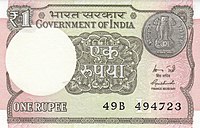Indian 1-rupee note
| (India) | |
|---|---|
| Value | ₹1 |
| Width | 97 mm |
| Height | 63 mm mm |
| Weight | 90 GSM g |
| Security features | Watermark |
| Material used | 100 per cent (Cotton) Rag Content |
| Obverse | |
 | |
| Design | One-rupee coin |
| Reverse | |
 | |
| Design | Sagar Samrat oil rig |
The Indian 1-rupee note (₹1) is made up of hundred 100 paisa's as ₹1 = 100 paise. Currently, it is the smallest Indian banknote in circulation and the only one being issued by the Government of India, as all other banknotes in circulation are issued by the Reserve Bank of India. As a result, the one rupee note is the only note bearing the signature of the Finance Secretary and not the Governor of the RBI.[1]Colour of the notes are Predominantly PINK GREEN. Printing of these notes were first stopped in 1926 and started in 1940 and continued till 1994 and stopped again due to Printing cost of such note. Again RBI started printing in 2015.It was released on 5 March 2015 at Srinathji Temple, Rajasthan by Rajiv Mehrishi, Finance Secretary. Once again RBI decided to issue these notes as per publication in the official Gazzettee I.e 7February 2020.
Pre independence issues
-
Indian one rupee note
-
British Indian one rupee note
See also
References
- ^ "Issue of Re. 1 denomination currency notes with Rupee symbol (₹) and the inset letter 'L'". RBI. Retrieved 6 January 2018.


